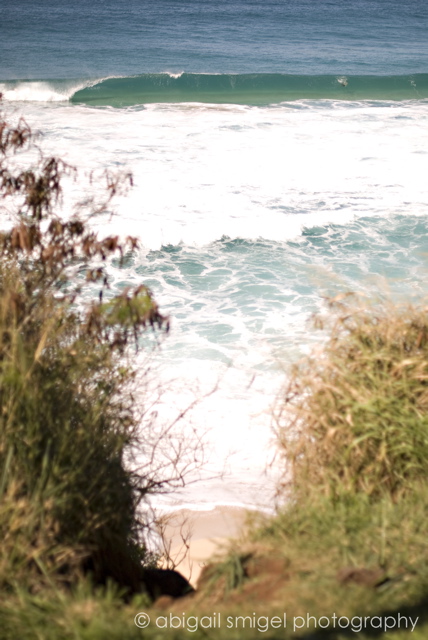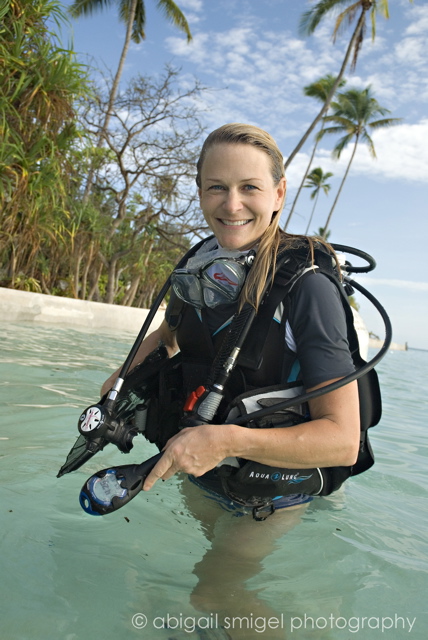For an open water student, nothing is quite as eagerly anticipated as the first ocean dive. For many divers, (especially in southern California,) this is a shore dive. Sounds easy enough you say. However, the average student-diver is likely worried about remembering the skills they worked on so diligently in the pool and may be nervous because they are not quite sure what to expect.
Shore diving involves a very important, albeit seemingly innocuous skill, which we emphasize during all of our pool sessions; the skill of donning and removing ones fins effortlessly. When going through surf, it is crucial to be able to put on and remove your fins quickly. We perform this skill poolside, along with reminders to practice at home. The importance of this message is never really appreciated fully until a student or even a new diver encounters a large wave face-to-face for the first time. On those perfect days when the ocean is flat like a pancake, there is no issue – but we would like all divers to be prepared for all conditions. The lucky days when the ocean is as glassy as a lake, we talk and laugh as everyone takes their sweet time trying to figure out how the buckles on their fins work while standing in waist deep water, and realizing that the strap needs to go under the foot as they slide their bootie into the toe box. It is when students try to figure out these nuances out in more challenging conditions, on the days when sets of waves are rolling in BIG, that we begin to have a problem.

Ocean surf is a thing of beauty to watch from a distance or even on shore, but waves that do not seem very big can suddenly look quite enormous and become quite intimidating when you are standing at the trough of one, perhaps perilously unprepared, as you try to don (this new foreign object to you,) a fin. As instructors, looking at students scattered in pairs, some with terror on their faces as the waves come pounding in, it seems reminiscent of what the Battle of Normandy might have looked like, watching students go down and struggling to get back up while holding loose fins in their hands. Yes, if only they had gotten used to sliding on those fins before now. You will do yourself and your instructor a huge favor by practicing this seemingly easy and obvious skill at least once at home, BEFORE your first shore dive.
After making it through the surf the surface swim begins, which can be another unanticipated torture for some students. At La Jolla Shores, with its gently sloping sandy bottom, it can be a distance of 200 yards to make it to a depth of 20 feet. It is always interesting to see the array of strategies being used to complete the swim to our float. There are those kicking on their back, some adding arm motion emulating a backstroke in full scuba gear. There is the snorkeling option, which could be a good choice if you occasionally look to see where you are going. Charting a course, however, is often neglected, and these students need to be chased and herded back to the group as they head off in variant directions. Everyone does eventually make it to the float, but that enthusiastic glint is gone from many eyes and at that moment, they hate life and perhaps us too.
The purpose of this article is not to dissuade new divers from shore diving, but rather to help them prepare in advance, so they do not have to endure unnecessary suffering. Here are a few tips to avoid these discomforts and make your first ocean dive an enjoyable experience:
1. Start getting in shape now. Do something aerobic like biking, walking, jogging, swimming, etc… on a regular basis. You will be way ahead of the pack, and may possibly be the first one to make it to the float. Gold star!
2. Eat a light meal and arrive well hydrated. If making two dives, bring along bottled water and a snack. Do not show up hung over! You and everyone else will regret it.
3. We mentioned it already, but sit down in your living room with your booties and gloves and take your fins on and off, again and again, with out looking. For a modest fee, get some spring straps to replace the standard buckles and straps on your fins. They will snap right over your booties in seconds, and you will love them.
4. Before entering the surf, make sure you have air in your BCD in case you fall. If the surf is big, your instructor might have you wear your mask and regulator for the entry. Watch for incoming waves, leaning into them to prevent being knocked over, and ducking under the larger ones.
5. Shuffle out to chest deep water before putting on your fins and the weight of the water will help balance you. At this point, you will be thankful you practiced slipping on your fins without looking because your feet will be underwater as you are strapping them on. Try to slip on each fin in between waves. After they are on you can lean back and start your kick out.
6. Do not let go of your fins under any circumstances. Have your buddy hang onto your spare fin while putting on your first one. You do not want to be looking for a lost fin while being pounded by surf.
7. Keep your mask on your face or around your neck. A facemask placed on top of the head is a lost mask. The surf will knock it off and you will never see it again. It also makes you look like either a novice diver or a diver in distress.
Believe it or not, shore diving is actually a lot of fun, and is a valuable skill because it has so many benefits. It is readily accessible, can be done on your own schedule, and is inexpensive. If you are comfortable shore diving, diving from a boat will seem extremely easy, and on trips you might find yourself being one of the best divers present and will have the satisfaction of knowing . . . you survived Shore Diving Boot Camp.

(editor: francesca.koe@deeperblue.com)
